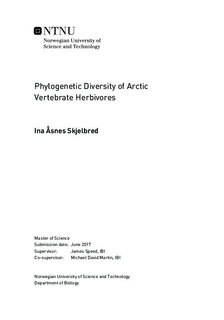| dc.description.abstract | Understanding spatial diversity patterns, and factors shaping these patterns, is crucial for conservation planning, and is particularly important in areas undergoing severe climatic change. Traditionally, spatial diversity patterns have been investigated solely at the species-level, using measurement of species richness. However, using a phylogenetic approach to measure biodiversity can increase our understanding and give insight to both ecological and evolutionary processes shaping the diversity patterns we see today. This study has investigated patterns of phylogenetic diversity of arctic vertebrate herbivores relative to patterns of species richness, and further explored possible explanatory variables driving the ratio between these patterns.
The spatial diversity analyses were performed using Biodiverse, linking species distribution data and molecular data (a phylogeny) in order to calculate the phylogenetic diversity of vertebrate herbivores across the entire Arctic biome. Environmental data were collected from various data sources, based on evaluation of which parameters that may be important drivers shaping the patterns.
The results showed a strong correlation between the patterns of phylogenetic diversity and species richness in arctic vertebrate herbivores. In addition, phylogenetic diversity was revealed to be higher than species richness across the Arctic, suggesting arctic areas to represent a span across the phylogenetic tree of species investigated, even in species-poor areas. Further, several arctic islands were identified as areas containing an overrepresentation of phylogenetic diversity relative to species richness compared to the Arctic mainland. Seven out of nine environmental variables investigated were found to be relative important driving patterns of both phylogenetic diversity and species richness. Of these, plant productivity, glaciation history, temperature, precipitation, habitat heterogeneity, and human impact were found to have a negative effect of phylogenetic diversity relative to species richness. On the other hand, topographic heterogeneity and distance to coast were found to have a positive effect. This study illustrates that a phylogenetic approach enhances our knowledge about spatial diversity patterns, and may possibly reveal areas of special interest regarding future conservation priorities. | |

